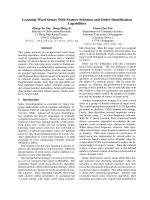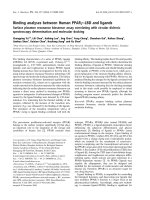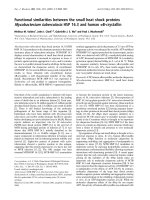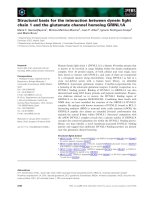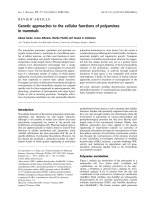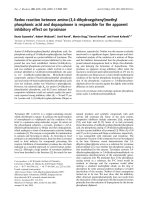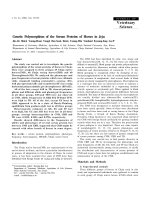báo cáo khoa học: "Genetic disequilibria between the α β-, κ-casein -, S1 and the β-lactoglobulin loci of the Bavarian Brown and Bavarian Simmental cattle" docx
Bạn đang xem bản rút gọn của tài liệu. Xem và tải ngay bản đầy đủ của tài liệu tại đây (384.73 KB, 9 trang )
Genetic
disequilibria
between
the
α
S1-,
β-,
κ-casein
and
the
β-lactoglobulin
loci
of
the
Bavarian
Brown
and
Bavarian
Simmental
cattle
(1)
R. GRAML,
J. BUCHBERGER
F.
PIRCHNER
Lehrstuhl
für
Tierzucht
der
Technischen
Universitdt
München,
D-8050
Freising-Weihenstephan
*
lnstitut
für
Chemie
und
Physik
der
Süddeutschen Versuchs-und
Forschungsanstalt
fi4r
Milchwirtschaft
der
Technischen
Universitilt
Miinchen,
D-8050
Freising-Weihenstephan
Summary
Genetic
disequilibria
between
3
casein
loci
and
between
them
and
the
(3-lactoglobulin
locus
were
estimated
for
a
Simmental
and
a
Braunvieh
sample
of
about
2
000
cows
each.
Between
the
casein
loci,
disequilibria
were
statistically
significant
but
between
them
and
the
independent
lactoglobulin
locus,
disequilibria
were
smaller
and
statistically
insignificant.
In
general,
sign
and
magnitude
of
the
casein
loci
disequilibria
were
similar
between
the
2
breeds.
Key
words :
Linkage
!;.!fq’t«7;!ftM!!,
gamete
frequency,
casein,
(3-lactoglobulin,
cattle.
Résumé
Déséquilibres
génétigues
entre
les
locus
as
,-,
(3-,
K
-caséine
et
[3-lactoglobuline
chez
les
bovins
des
races
Brune et
Simmental de
Bavière
On
a
estimé
les
déséquilibres
génétiques
entre
3
locus
des
caséines
et
entre
ceux-ci
et
le
locus
de
la
(3-lactoglobuline
dans
des
échantillons
Simmental
et
Braunvieh
d’environ
2 000
vaches
chacun.
Les
déséquilibres
entre
les
locus
des
caséines
sont
statistiquement
significatifs
mais,
entre
ceux-ci
et
le
locus
indépendant
de
la
lactoglobuline,
les
déséquilibres
sont
plus
faibles
et
statistiquement
non
significatifs.
En
général,
le
signe
et
l’importance
des
déséquilibres
entre
les
locus
des
caséines
sont
similaires
dans
les
2
races.
Mois
clés :
Déséquilibre
de
«
linkage
»,
fréquence
gamétique,
caséine,
(3-lactoglobuline,
bovins.
(1)
The
investigation
was
supported
by
the
Deutsche
Forschungsgemeinschaft.
I.
Introduction
Neutral
alleles
at
different
loci
should
be
in
Hardy-Weinberg
and
in
linkage
equilibrium
in
large
panmictic
populations.
Linkage
disequilibria
can
occur
because
selection
may
cause
an
association
between
gene
B
at
locus
Lg
saj
and
gene
A
at
locus
as
,-Cn.
Alternatively,
disequilibrium
may
be
a
consequence
of
random
drift
(HILL
&
R
OBERTSON
,
1968)
or
it
may
result
from
mixing
of
2
previously
isolated
and
genetically
different
populations.
Also
gene
fre-
quency
changes
due
to
selection
at
a
locus
may
generate
linkage
disequilibrium
between
2
adjacent
neutral
loci
(T
HOMSON
,
1977).
CROW
&
KIMU!
(1970)
show
that
weak
linkage
and
weak
epistasis
may
sustain
a
stable
disequilibrium.
Linkage
between
casein
loci
(G
ROSCLAUDE
et
al.,
1964, 1965,
1978 ;
L
ARSEN
&
T
HYMANN
,
1966 ;
H
INES
et
al.,
1969)
is
one
of
the
few
linkages
hitherto
known
in
cattle.
The
recombination
frequency
between
casein
loci
is
5
p.
100
or
less
(G
ROS
-
CLAUDE
et
al.,
1964 ;
H!rrES
et
al.,
1969 ;
L
ARSEN
,
1970),
that
between
casein
loci
and
the
lactoglobulin
locus
1/2.
It
appears
to
be
of
interest
to
investigate
the
status
of
linkage
equilibria
among
casein
loci
and between
these
and
the
[3-lactoglobulin
locus
in
German
cattle
breeds
not
investigated
before.
II.
Material
and
methods
Casein
and
lactoglobulin
genotypes
were
determined
in
2
rather
large
samples
of
Bavarian
Simmentals
(FV)
(N
=
2
262)
and
Bavarian
Brown
cattle
(BV)
(N
=
2
139)
and
gene
frequencies
were
estimated
therefrom
(G
RAML
et
al.,
1984
a,
b).
The
Simmen-
tal
can
be
considered
as
a
closed
dual
purpose
breed
while
the
Bavarian
Brown
sample
embraces
about 70
p.
100
of
Bavarian
Brown
x
Brown
Swiss
crosses
of
various
degrees.
The
Brown
Swiss
share
of
the
genotypes
is
in
most
cows
less
than
50
p.
100.
The
principal
aim
of
the
investigation
was
to
estimate
the
effects
of
milk
protein
genes
on
milk
constituents
but
also
the
heritabilities
of
these
were
to
be
estimated.
Therefore
for
the
FV
sample,
data
collection
was
organized
in
such
a
way
that
at
least
2
daughter-dam
pairs
were
located
at
any one
farm.
In
some
cases
a
cow
was
both
daughter
and
dam.
However,
some
single
animals
were
also
included.
In
the
BV
sample,
all
cows
in
a
herd
were
studied.
Therefore,
the
daughter-dam
pairs
comprised
about
half
of
the
animals.
Numbers
of
animals
in
the
2
breeds
and
in
the
different
categories
are
given
in
table
1.
The
determination
of
the
protein
types
has
been
described
elsewhere
(G
RAML
et
al.,
1984
a).
Suffice
here
to
state
that
samples
were
not
tested
in
acid
gels,
which
precluded
differentiation
of
(3-Cn
A’,
A 2,
A’.
For
3
casein
loci
and
the
f3-lactoglobulin
locus,
84
different
genotype
combinations
were
detectable
in
the
Simmental
material
and
91
in
the
Bavarian
Brown
sample.
Several
linkage
disequilibria
are
possible
if
multiple
alleles
exist
at
the
loci :
Dij !
f
ij
-
piqj,
where
f
ij
represents
the
gametic
frequency
for
AiBj,
p;
and
q,,
the
allelic
frequencies
of
the
genes
A;
and
Bj
at
the
2
loci.
When
m
alleles
are
at
the
first
locus,
and
n
alleles
at
the
second,
mn
linkage
disequilibria
are
possible.
There
are
(m -
1)
(n —
1)
independent
coefficients
(WEIR,
1979).
All
disequilibria
D
ii
are
estimable
only
if
all
gametes,
including
those
of
double
heterozygotes,
are
identifiable.
For
the
casein
loci,
coupling
and
repulsion
double
heterozygotes
cannot
be
distinguished.
Therefore,
gamete
frequencies
were
estimated
by
allocation
(C
EPPELLINI
et
al.,
1955).
The
statistical
significance
of
the
disequilibria
was
tested
by
a X2
with
one
degree
of
freedom
as
has
been
suggested
by
WEIR
&
C
OCKERHAM
(1978) :
Here
Di,
represents
the
disequilibrium
between
loci
i
and j
and
p;,
qj
the
gene
frequencies
at
the
2
loci.
r
ij
denotes
the
gametic
correlation
and
N
equals
the
number
of
gametes
in
the
sample.
In
our
samples
the
rare
alleles
D
of
p-lactoglobulin
and
C
of
(3-casein
have,
as
a
consequence,
low
gamete
frequencies
which
possibly
could
fake
disequilibria.
Therefore,
in
a
second
analysis
these
alleles
were
pooled
with
alleles
A
and
B
of
the
respective
loci.
The
significance
was
tested
by
similar
to
the
quantities
given
above
but
under
conditions
Frequencies
of
casein
gametes
are
given
in
table
2.
They
are
fairly
similar
between
breeds
and
between
age
groups
albeit
the
gametes
a,,-Cn
B
[3-Cn
B
and
as
,-Cn
e
K
-Cn
B
have
a
somewhat
higher
frequency
in
BV
than
in
FV
while
the
reverse
is
true
for
the
BA
gametes.
No
significant
linkage
disequilibrium
was
found
between
the
casein
loci
and
the
p-
lactoglobulin
locus.
The
estimated
disequilibria
between
casein
loci
are
given
in
table
3
as
squares
of
the
gametic
correlations
together
with
the
sign
of
D.
In
table
3
rare
gametes
are
included,
i.e.
r;
values
are
shown.
Several
disequilibria
are
statistically
significant
and
that
is
true
for
combinations
between
all
3
casein
loci.
Also
the
signs
of
the
disequilibria
tend
to
be
the
same
in
both
breeds.
Also
in
table
3
disequilibria
computed
from
pooled
frequencies
are
given
and
some
of
the
disequilibria
are
statisti-
cally
significant.
IV.
Discussion
The
similarity
of
the
casein
loci
disequilibria
in
all
samples
and
the
fact
that
some
are
significant
statistically
indicate
that
the
disequilibria
are
real.
As
mentioned
before,
disequilibria
may
be
caused
by
random
drift
in
small
populations,
recent
hybridization
and
selection.
WEIR
&
HILL
(1980)
showed
that
in
populations
of
limited
effective
size
(N
J
loci
with
recombination
frequency
c
should
have
a
linkage
disequilibrium
between
them
which
can
be
approximated
by
The
approximation
is
good
in
particular
if
loci
are
independent.
The
effective
population
size
of
FV
appears
to
be
around
140
(P
IRCHNER
,
1983).
Since
the
daughter
sample
is
1 076
(n
j
one
may
expect
r’
=
.0033
between
independent
loci
and
r2
=
.0341
between
linked
casein
loci
with
are
somewhat
larger
than
the values
observed.
However,
the
effective
size
of
the
Braunvieh
population
must
be
larger
since
much
of
it
consists
of
Braunvieh
x
Brown
Swiss
crosses.
The
tBV
sample
consists
largely
of
rBV
x
BS
crosses
and
disequilibria
are
expec-
ted
if
the
gamete
frequencies
in
the
respective
parent
populations
are
sufficiently
different.
G
RAML
et
al.
(1984
b)
report
little
difference
between
the
gene
frequencies
of
Bavarian
Braunvieh
(rBV)
and
Brown
Swiss
and
as
evident
from
table
2
gamete
frequencies
appear
to
be
rather
similar
between
rBV
and tBV.
Also
r’
values
of
tBV
tended
to
be
smaller
than
in
rBV.
Therefore
it
appears
that
the
hybridization
between
rBV
and
BS
is
not
the
major
cause
of
the
linkage
disequilibria
observed.
However,
the
similarity
in
sign
and
extent
of
linkage
disequilibria
between
Fleck-
vieh
and
Braunvieh
appears
to
us
to
be
an
indicator
for selection
as
a
cause
of
the
disequilibria.
It
must
be
pointed
out
that
the
2
breeds
even
though
close
in
terms
of
their
ultimate
genealogy
(K
IDD
&
P
IRCHNER
,
1971)
have
been
separated
for
a
long
time.
respective
areas
of
distribution
were
sharply
delimited
and
any
hybridization
was
frowned
upon
and
it
certainly
did
not
occur
between
the
principal
breeding
centers
in
the
Simmental
on one
hand
and
Eastern
Switzerland
and
Western
Austria
on
the
other.
In
table
4
we
have
listed
linkage
disequilibria
between
casein
loci
in
various
cattle
breeds
which
have
been
reported
in
the
literature
or
which
could
be
computed
from
gamete
frequencies
given
in
the
respective
publications.
It
is
evident
that
linkage
disequilibria
between
a,,-Cn
and
f3-Cn
are
identical
in
sign
in
nearly
all
breeds
investigated.
The
one
exception
is
a
sample
of
Red
Pied
Aosta.
In
contrast
linkage
disequilibria
between
the
(x,,-Cn
and
the
K
-Cn
locus
vary
between
breeds.
In
our
Bavarian
Braunvieh
sample
(tabl.
3)
the
linkage
disequilibrium
was
negative
between
the
respective
BA
alleles
at
the
2
loci
and
it
changed
to
rather
strong
positive
disequilibrium
in
the
rBV
granddams,
but
when
all
age
groups
were
combined
no
linkage
disequilibrium
of
any
size
seemed
to
exist.
The
linkage
disequilibria
between
the
(3-Cn
and
the
K
-Cn
loci
where
BA
resp.
CA
gametes
are
involved
vary
between
breeds.
The
disequilibrium
between
the
A
alleles
at
both
loci
differs
between
breeds
but
this
may
be
caused
by
the
lack
of
differentiation
between
the
A’,
Nand
A3
alleles
at
the
f3-Cn
locus
which
however
did
not
prevent
the
recognition
of
the
disequilibria
between
the
f3-Cn
and
the
a,,-Cn
loci.
In
our
tBV
sample
the
disequilibrium
between
(3-Cn
B and
K
-Cn
A
was
contrary
in
sign
to
the
majority
of
the
disequilibria
in
the
other
breeds.
The
significant
negative
disequilibrium
is
caused
by
the
high
frequency
of
respective
gametes
in
the
rBV
sample
thus
possibly
be
the
exception
explainable
by
the
recent
crossbreeding.
The
similarity
of
the
disequilibria
between
the
as
,-Cn
and
a-Cn
loci
not
only
between
our
2
breeds
but
also
in
many
other
breeds,
and
the
evidence
of
epistatic
contributions
to
the
genetic
variance
(G
RAML
,
1982)
lead
us
to
suggest
that
selection
is
a
cause,
possibly
an
important
one,
of
disequilibria
between
milk
protein
gene
loci.
Received
November
27,
1984.
Accepted
July
15,
1985.
References
C
EPPELLINI
R.,
S
INISCALCO
M.,
SMITH
C.A.B.,
1955.
The
estimation
of
gene
frequencies
in
a
random-mating
population.
Ann. hum.
Genet.,
20,
97-115.
CROW
J.F.,
K
IMURA
M.,
1970.
An
Introduction
to
Population
Genetics
Theory,
195
pp.,
Harper
and
Row,
New
York.
G
RAML
R.,
1982.
EinfluJ3
von
Markergenen
auf
Milchzusammensetzung,
134
pp.,
Diss.
Munchen-
Weihenstephan.
G
RAML
R.,
B
UCHBERGER
J.,
K
IRCHMEIER
O.,
IC
IERMEIER
F.,
P
IR
C
HNER
F.,
1984
a.
GenfrequenzschAt-
zung
bei
Milchproteinen
des
bayerischen
Fleckviehs.
Ziichtungskunde,
56,
73-87.
G
RAML
R.,
B
UCHBERGER
J.,
K
LOSTERMEYER
H.,
P
IRCHNER
F.,
1984
b.
Untersuchungen
iiber
die
Genfrequenzen
der
Caseine
und
R-Lactoglobuline
bei
der
bayerischen
Braunviehpopulation.
Ziichtungskunde,
56,
221-230.
G
ROSCLAUDE
F.,
1974.
Analyse
g6netique
et
biochimique
du
polymorphisme
electrophoretique
des
caseines
as
&dquo;
0 et
K
chez
les
bovins
(Bos
taurus)
et
les
zebus
(Bos
indicus).
These
de
Doctorat
d’Etat,
Universite
Paris
VII.
G
ROSCLAUDE
F.,
G
ARNIER
J.,
R
IBADEAU
-DuMAs
B.,
J
EUNET
R.,
1964.
Etroite
dependance
des
loci
contr61ant
le
polymorphisme
des
caséines
a,
et
(3.
Compt.
Rend.
Acad.
Sci.
(Paris),
259,
1569-1571.
G
ROSCLAUDE
F.,
.I
OUDRIER
P.,
M
AHE
M.F.,
1978.
Polymorphisme
de
la
caséine
o.s2
bovine :
étroite
liaison
du
locus
Ol
s2-Cn
avec
les
loci
a,,-Cn,
(3-Cn
et
K
-Cn ;
mise
en
evidence
d’une
deletion
dans
le
variant
o.
s2-Cn
D. Ann.
Génét.
Sel.
Anim.,
10,
313-327.
G
ROSCLAUDE
F.,
P
UJOLLE
J.,
G
ARNIER
J.,
R
IBADEA
u-DUMAs
B.,
1965.
D6terminisme
gen6tique
des
casdines
du
lait
de
vache ;
6troite
liaison
du
locus
K
-Cn
avec
les
loci
a-Cn
et
(3-Cn.
Compt.
Rend.
Acad.
Sci.
(Paris),
261,
5229-5232.
HILL
W.G.,
R
OBERTSON
A.,
1968.
Linkage
disequilibrium
in
finite
populations.
Theor.
Appl.
Genet.,
38,
226-231.
’ H
INES
H.C.,
H
AENLEIN
G.F.W.,
Z
IKAKIS
J.P.,
DICKEY
H.C.,
1977.
Blood
antigen,
serum
protein,
and
milk
protein
gene
frequencies
and
genetic
interrelationships
in
Holstein
cattle.
J.
Dairy
Sci.,
60,
1143-1151.
H
INES
H.C.,
KIDDY
C.A.,
BRUM
E.W.,
A
RAVE
C.W.,
1969.
Linkage
among
cattle
blood
and
milk
polymorphisms.
Genetics,
62,
401-412.
K
IDD
K.K.,
P
IRCHNER
F.,
1971.
Genetic
relationships
of
Austrian
cattle
breeds.
Anim.
Blood
Grps
biochem.
Genet.,
2,
145-158.
KING
J.W.B.,
A
SCHAFFENBURG
R.,
KIDDY
C.A.,
T
HOMP
S
ON
M.P.,
1965.
Non-independent
occur-
rence
of
a,,-
and
p-casein
variants
of
cow’s
milk.
Nature,
206,
324-325.
L
ARSEN
B.,
1970.
Koblingsrelationer
mellem
blod-
og
polymorfe
proteintypesystemer
hos
kvaeg.
Aarsberetn.
Inst.
Sterilitetsforskn.
(Copenhagen),
13,
165-194.
L
ARSEN
B.,
T
HYMANN
M.,
1966.
Studies
on
milk
protein
polymorphism
in
Danish
cattle
and
the
interaction
of
the
controlling
genes.
Acta
vet.
Scand.,
7,
189-205.
MERLIN
P.,
Di
S
TAS
to
L.,
1982.
Study
on
milk
proteins
loci
in
some
decreasing
Italian
cattle
breeds.
Ann.
Genet.
Sel.
Anim.,
14,
17-28.
P
IRCHNER
F.,
1983.
Population
Genetics
in
Animal
Breeding,
61
pp.,
Plenum
Press,
New
York
and
London.
T
HOMSON
G.,
1977.
The
effect
of
a
selected
locus
on
linked
neutral
loci.
Genetics,
85,
753-788.
VoGLINO
G.F.,
C
ARIGNANO
1.,
1975.
Association
between
a,,-,
fl-
and
K
-casein
loci
in
two
Italian
cattle
breeds.
Anim.
Blood
Grps
biochem.
Genet.,
6,
175-183.
WEIR
B.S.,
1979.
Inferences
about
linkage
disequilibrium.
Biometrics,
35,
235-254.
WEIR
B.S.,
C
OCKERHAM
C.C.,
1978.
Testing
hypothesis
about
linkage
disequilibrium
with
multiple
alleles.
Genetics,
88,
633-642.
WEIR
B.S.,
HILL
W.G.,
1980.
Effect
of
mating
structure
on
variation
in
linkage
disequilibrium.
Genetics,
95,
477-488.

